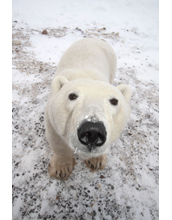Multimedia Gallery
Polar Bear Ancestry Traced to Ireland (Image 5)
Climatological data suggests that the planet is currently experiencing another warming period--known as the Holocene or the Present Interglacial--that is even warmer than the period that marked the beginning of the last ice age. Changes in arctic climate, melting glacial ice, fewer sea-ice days, longer open-water periods during summer, and rising sea levels are providing polar and brown bears with the opportunity to share habitats and to hybridize. Several adult hybrid bears have been reported in the last five years. These hybrids may play an underappreciated role in the survival of certain species. [Image 5 of 5 related images. Back to Image 1.]
More About This Image
An international research team led by Beth Shapiro, the Shaffer associate professor of biology at the Pennsylvania State University, and Daniel Bradley of Trinity College, London, concluded that all living polar bears trace their maternal ancestor to a brown bear that lived near present-day Britain and Ireland just prior to the last ice age. The research team analyzed 242 brown bear and polar bear mitochondrial lineages sampled throughout the last 120,000 years and across multiple geographic ranges. They found that the fixation of the mitochondrial genome likely occurred during or just before the peak of the last ice age, possibly as early as 50,000 years ago. The specific population of brown bears that shared its maternal DNA with polar bears has been extinct for roughly 9,000 years, says Shapiro.
Climate change has forced polar and brown bears to share habitats. Occasionally, the two species interbreed and produce hybrid bears. Periods of warming and cooling during the last 500,000 or more years created conditions that were favorable for hybridization between the two bear species. "Polar and brown bears likely came into contact intermittently, in particular in coastal regions where the effects of climate change may have been more pronounced," says Shapiro. "Whenever they come into contact, there seems to be little barrier to their mating."
Results of the study are expected to help guide future conservation efforts for polar bears, which are listed as threatened under the Endangered Species Act. The research was supported in part by a grant from the National Science Foundation (grant EF 04-23641).
To learn more, see the Penn State news story Ancestry of Polar Bears Traced to Ireland. (Date of Image: 2010-2011)
Credit: Daniel J. Cox/NaturalExposures.com
Images and other media in the National Science Foundation Multimedia Gallery are available for use in print and electronic material by NSF employees, members of the media, university staff, teachers and the general public. All media in the gallery are intended for personal, educational and nonprofit/non-commercial use only.
Images credited to the National Science Foundation, a federal agency, are in the public domain. The images were created by employees of the United States Government as part of their official duties or prepared by contractors as "works for hire" for NSF. You may freely use NSF-credited images and, at your discretion, credit NSF with a "Courtesy: National Science Foundation" notation.
Additional information about general usage can be found in Conditions.
Also Available:
Download the high-resolution JPG version of the image. (535 KB)
Use your mouse to right-click (Mac users may need to Ctrl-click) the link above and choose the option that will save the file or target to your computer.

